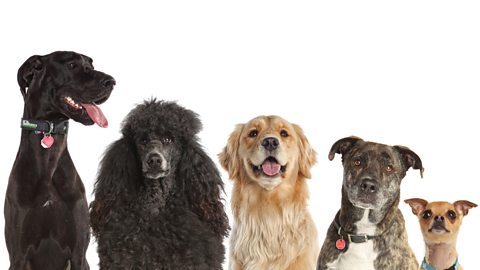Mutation and variation
Extensive genetic variation is contained within any species. This is clearly visible in the domestic dog species.

Variation within genes leads to different genotypeThe alleles that an organism has for a particular characteristic, usually written as letters., and this can be seen by a different phenotypeThe visible characteristics of an organism which occur as a result of its genes.. Genetic and environmental variation combine together to produce these different phenotypes. All variants arise from mutationA random and spontaneous change in the structure of a gene, chromosome or number of chromosomes. and most have no effect on the phenotype.
A mutation is a change in a geneThe basic unit of genetic material inherited from our parents. A gene is a section of DNA which controls part of a cell's chemistry - particularly protein production. or chromosomeThe structure made of DNA that codes for all the characteristics of an organism.. Mutations arise spontaneously and happen continually. A mutation rarely creates a new phenotype, but if the phenotype is suited to a particular environment, it can lead to rapid change in a species.
For example, if a mutation leads to a change, such as feather colouring in birds, this new change may allow those individuals to reproduce more frequently, due to them being more attractive and seen as a more desirable mate. This would result in this phenotype being passed on more successfully than the birds of the same species without the new phenotype.
Natural selection
Natural selection is a process where organisms that are better adapted to an environment will survive and have more offspring. This means their genes are passed on to the future generations. This process is fundamental to the process of evolutionThe process of change in the inherited traits of a population of organisms from one generation to the next..
Charles Darwin was a famous English naturalist, who during his life came up with a theory of evolution. He is associated with the term 'survival of the fittest' which describes how natural selection works, by selecting the best examples of an organism to survive. For example, individuals that are best adapted to their environments are more likely to survive and therefore reproduce.
A famous example of this is the peppered moth.
During the nineteenth century, pollution killed off some of the lichenA type of fungus that grows on rock. and soot deposits caused the bark on trees to appear darker. Light coloured moths were no longer camouflageAn ability to blend in with a background. and were eaten by birds. The dark moths had a better camouflage.
As a result, dark moths had a greater chance of reproducing and passing on the phenotypeThe visible characteristics of an organism which occur as a result of its genes., and through this the allelesDifferent forms of the same gene. that made them dark. This led to a gradual increase in the proportion of dark moths until light moths became very rare in industrial areas.
Note that this change was not due to pollution making the moths darker. The dark variety had always existed, but had an advantage when the environment changed.